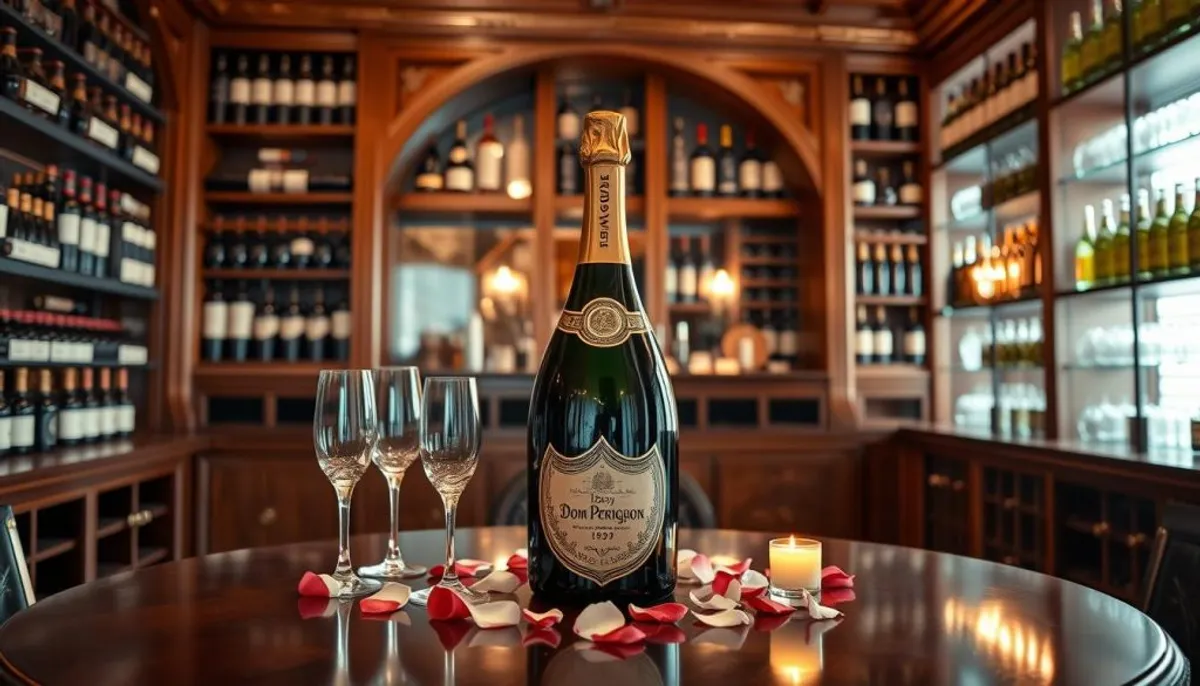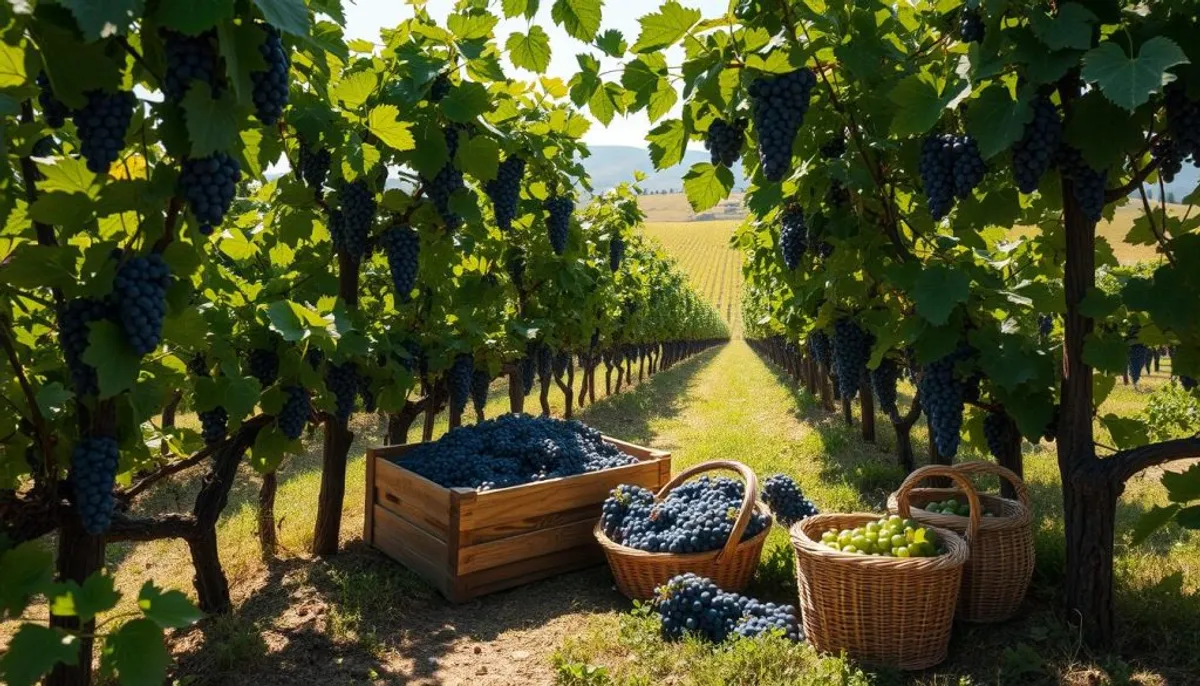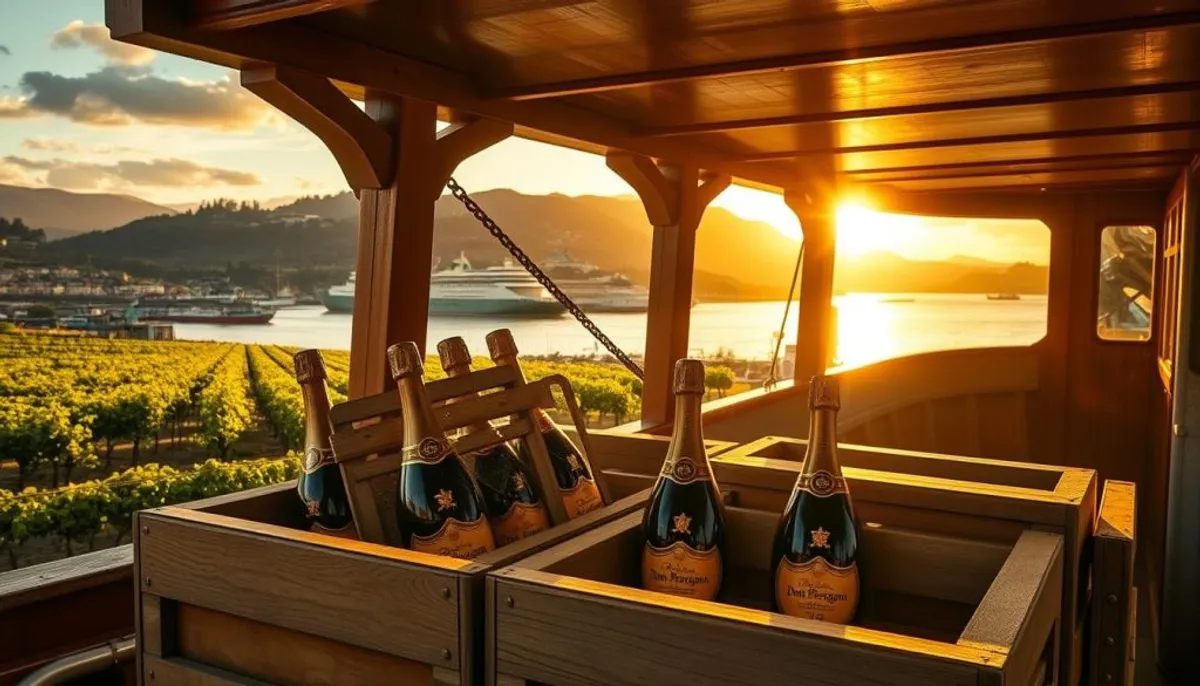Enter the realm of luxury wine with the iconic 1959 Dom Perignon. This vintage champagne, created by Moët & Chandon in France’s Champagne region, represents a significant milestone in winemaking. It transcends mere consumption; it embodies a moment in time, preserved within a bottle.
The 1959 vintage is celebrated as the inaugural year of Dom Perignon Rosé. With only 306 bottles produced, it has become a coveted collector’s item. This scarcity has ignited a fierce competition among connoisseurs, with Christie’s auctions witnessing unprecedented sales.

What distinguishes this vintage champagne? It is the harmonious union of Pinot Noir and Chardonnay grapes, aged to perfection. This synergy yields a complex flavor profile, earning it widespread acclaim from wine critics. It is no surprise that the 1959 Dom Perignon has established itself as a paragon of luxury wines globally.
Key Takeaways
- 1959 marks the first year of Dom Perignon Rosé production
- Only 306 bottles of the 1959 Rosé were made
- The vintage has set auction records at Christie’s
- It’s a blend of Pinot Noir and Chardonnay grapes
- The 1959 vintage is considered a benchmark in luxury wines
The Historical Significance of 1959 Dom Perignon
The 1959 Dom Perignon vintage is a landmark in Champagne milestones. It marked a significant shift in Dom Perignon history, establishing new benchmarks for vintage champagne production and innovation.
A Milestone in Champagne Production
In 1959, Dom Perignon transcended traditional boundaries in crafting exceptional sparkling wines. Their unwavering dedication to excellence was evident as they refined their methods. This resulted in a vintage that would be celebrated for generations to come, much like the exquisite duperrey champagne.
First Year of Dom Perignon Rosé Production
The introduction of Dom Perignon Rosé in 1959 was a groundbreaking achievement. This move expanded the brand’s elite offerings and set a new benchmark for luxury rosé champagnes. The rosé underwent nearly 12 years of aging in Moet & Chandon’s cellars before its release.
The Legacy of the 1959 Vintage
The 1959 vintage profoundly impacted Dom Perignon’s legacy. It exemplified the brand’s commitment to innovation and quality, laying the groundwork for future successes. This vintage became a paragon of excellence in the realm of vintage champagne.
| Aspect | Detail |
|---|---|
| Year | 1959 |
| Significance | First Dom Perignon Rosé |
| Aging Period | Nearly 12 years |
| Impact | Set new standards for luxury rosé champagnes |
The Birth of a Luxury Icon: Dom Perignon’s Heritage
Dom Perignon, a name that echoes luxury, originates from a Benedictine monk who significantly influenced Champagne’s history. The brand’s inception occurred in 1921, yet it wasn’t until 1936 that the first bottles were introduced to the market. This initial delay solidified Dom Perignon’s reputation as a rare and unparalleled product.
In 1927, Champagne Mercier transferred the Dom Perignon brand to Moët, marking the start of a new chapter in luxury wine production. The champagne quickly garnered attention from high-profile consumers, solidifying its status as a premium offering. Among the notable selections in this realm is duperrey champagne, which exemplifies the artistry and craftsmanship of fine champagne.
Dom Perignon’s production is both exclusive and widespread. Each vintage produces between five to eight million bottles, distributed worldwide. The blend typically consists of equal parts Chardonnay and Pinot Noir, though the ratio can vary by up to 10%.
| Aspect | Detail |
|---|---|
| First Vintage | 1921 |
| Market Release | 1936 |
| Annual Production | 5-8 million bottles |
| Grape Blend | Equal parts Chardonnay and Pinot Noir (±10%) |
| Current Dosage | Approximately 5 grams per liter |
Dom Perignon’s dedication to excellence is evident in its evolving production techniques. The dosage has been reduced from 8 to 5 grams per liter, aligning with modern preferences for less sweet wines. This focus on detail and adaptation to consumer tastes has ensured Dom Perignon’s continued dominance as a leading luxury wine brand.
Crafting Excellence: The 1959 Vintage Production Process
The 1959 Dom Perignon vintage was a landmark in champagne production. It introduced Dom Perignon Rosé, broadening the elite range. Moët & Chandon’s dedication to excellence was evident in their winemaking techniques.
Grape Selection and Harvesting
The vintage selection process began with careful grape picking. Only the most superior Chardonnay and Pinot Noir grapes were selected. The 1959 harvest produced exceptional fruit, laying the groundwork for a memorable vintage.

Blending and Aging Techniques
The art of blending is fundamental in champagne production. For the 1959 vintage, a balanced blend of Chardonnay and Pinot Noir was crafted. The wine aged in Moët & Chandon’s extensive cellars, spanning 28 kilometers underground. These cellars offer perfect conditions for aging.
Quality Control Standards
Stringent quality control ensured only the highest-quality bottles reached the market. Each production step was meticulously examined, from grape selection to the final tasting. This meticulous approach is why Dom Perignon is only produced in outstanding years, making it a favored choice for high-end events.
| Production Stage | Quality Control Measure |
|---|---|
| Grape Selection | Hand-picking of premium grapes |
| Pressing | Gentle extraction to preserve flavors |
| Fermentation | Temperature-controlled process |
| Aging | Extended period in historic cellars |
| Tasting | Expert panel evaluation |
Tasting Profile of the 1959 Dom Perignon
The 1959 Dom Perignon exemplifies the pinnacle of vintage champagne craftsmanship. It has enthralled connoisseurs with its unparalleled wine tasting notes and distinctive aged champagne characteristics.
Aroma and Bouquet Characteristics
This vintage presents itself with a light gold hue, a sign of its maturity. Its bouquet is ripe, generous, and refined. Critics note aromas of coffee, toast, and honey, complemented by subtle mineral undertones.
Palate and Flavor Notes
The palate of this champagne is a symphony of vintage flavors. It is medium-bodied, with silky tannins, showcasing a harmonious blend of waxy, buttery, and toasty notes. Its elegance is evident in its dry profile and average acidity, culminating in a long, lingering finish.
Aging Potential and Evolution
The 1959 Dom Perignon showcases remarkable aging potential. Its complex flavor profile evolves over time, revealing new layers with extended cellaring. This vintage scored an impressive 95 points, ranking it among the world’s top wines. Despite some bottle variation, 13 out of 17 professionals endorse this aged champagne, confirming its enduring quality.
| Characteristic | Description |
|---|---|
| Color | Light gold |
| Body | Medium |
| Tannins | Silky |
| Acidity | Average |
| Finish | Long, lingering, smooth |
The Royal Connection: Notable Collectors and Celebrations
Dom Perignon’s stature as a royal champagne is well-established, thanks to its appearances at elite gatherings and in the collections of affluent wine enthusiasts. Its royal heritage traces back to 1971, when the Shah of Iran commissioned several bottles of the inaugural Dom Perignon Rosé (1959) for a grand celebration.
This pivotal moment underscored the champagne’s significance. The entire 1959 Dom Perignon Rosé production was reserved for the Shah’s event, marking the 2,500th anniversary of the Persian Empire. This exclusive allocation underscored Dom Perignon’s status as a luxury and celebration emblem.
Dom Perignon’s royal associations have grown stronger over time. In 1981, it was selected for the wedding of Lady Diana Spencer and Prince Charles. Special magnums of the 1961 vintage, adorned with a unique insignia, were served at the ceremony. This further solidified Dom Perignon’s royal legacy.
These connections underscore Dom Perignon’s prestige and its role in pivotal historical events. The champagne is highly sought after by luxury wine collectors, who value its rarity and historical importance. With only 42 vintages released to date, each bottle is a testament to winemaking history.
Dom Perignon remains a staple at elite events globally, from Hollywood galas to royal festivities. Its inclusion at these occasions reinforces its status as a quintessential royal champagne, cherished by aficionados and collectors alike.
Investment Value and Auction Performance
The rare wine market has seen Dom Perignon excel in wine auctions. Vintage champagne investment remains a draw for collectors and enthusiasts, with Dom Perignon at the forefront of value appreciation and auction success.
Historical Auction Results
Dom Perignon’s auction history is marked by outstanding achievements. In 2008, a bottle of Dom Perignon Rose 1959 sold for an astonishing $84,700 at a New York auction. This sale highlights the immense value rare vintages command in the wine auction world.
Current Market Valuations
Recent trends show significant growth in Dom Perignon’s value. The 1993 Dom Perignon P2 Plenitude Brut saw a remarkable 1,308% price increase, from $346 to $4,870, between November 2021 and April 2023. The 2010 Dom Perignon Brut also rose by 49%, from $188 to $281, in less than two years.
Collection and Storage Considerations
Proper storage is essential for preserving the value of vintage champagne investments. Dom Perignon wines are released after extensive aging: Vintage after 7-9 years, P2 after 15-20 years, and P3 after 25-30 years. This aging process enhances the wine’s complexity and investment potential.
| Dom Perignon Type | Price Range | Notable Sale |
|---|---|---|
| Standard Vintage | $250+ | – |
| Brut Champagne | $290+ | – |
| Rosé | $460+ | 1959 Rosé: $84,700 (2008) |
| P3 Plenitude Brut Rosé | $5600+ | – |
Dom Perignon’s Revolutionary Impact on Champagne Making
Dom Perignon has been a trailblazer in champagne innovation since its inception. The brand’s commitment to producing only vintage champagnes has set new standards in luxury wine production. Their rigorous selection process and unique approach to aging have redefined premium champagne making.
In the realm of winemaking history, Dom Perignon introduced the concept of “plénitudes.” This innovative aging method has influenced how high-end champagnes are produced and marketed. The brand’s dedication to excellence is evident in their meticulous quality control standards, which have raised the bar for the entire industry.
A significant milestone in champagne innovation came in 1959 when Dom Perignon introduced their rosé variant. This bold move showcased the brand’s innovative spirit and willingness to push boundaries in luxury wine production. The 1959 vintage marked a turning point in winemaking history, setting Dom Perignon apart as a true innovator in the champagne world.
- Pioneered vintage-only champagne production
- Introduced the “plénitudes” aging concept
- Launched the first Dom Perignon Rosé in 1959
Dom Perignon’s revolutionary impact on champagne making continues to shape the industry today. Their unwavering commitment to quality and innovation ensures that each bottle of Dom Perignon represents the pinnacle of luxury wine production and champagne excellence.
The Prestige of Vintage Years
Dom Perignon’s legacy is deeply rooted in the realm of vintage champagne years. This renowned brand has consistently crafted exceptional wines, each vintage showcasing the distinct traits of its harvest year. Grasping the nuances of wine classification is crucial for appreciating the exclusivity and value of specific Dom Perignon releases.
Understanding Vintage Classification
Dom Perignon stands as a paragon of vintage champagne, crafted only in years where the harvest meets stringent criteria. Since 1921, the brand has unveiled 44 Brut vintage bottles, each embodying a year of unparalleled quality. The classification system for Dom Perignon is uncompromising, guaranteeing the use of only the finest grapes in its production.
Notable Vintages from 1921 to 1959
The early years of Dom Perignon were marked by several extraordinary vintages. Between 1921 and 1959, 13 Dom Perignon vintages were produced. Among these, the 1921, 1928, 1929, and 1947 vintages are celebrated for their excellence. The 1959 vintage is notable as it marked the inaugural year of Dom Perignon’s rosé production.
| Year | Significance |
|---|---|
| 1921 | First Dom Perignon vintage |
| 1947 | Exceptional post-war vintage |
| 1959 | First Dom Perignon Rosé |
Dom Perignon’s prestige endures, with each new vintage contributing to its storied legacy. Recent years like 1990, 1996, 2002, and 2008 have solidified Dom Perignon’s status as a pinnacle of fine wines. These vintage champagne years command substantial prices, with some bottles reaching into the thousands at auction, underscoring their esteemed position in the world of wine.
Champagne Export: From Cellar to Global Market
The global wine market has witnessed a significant increase in champagne shipping, with Dom Perignon at the forefront. Wine export statistics unveil intriguing trends within the sparkling wine sector.
Authentication and Provenance
For high-value vintages such as the 1959 Dom Perignon, authentication is paramount. Detailed records and proper documentation are vital for auction sales. These steps are crucial to uphold the integrity of rare champagnes as they transition into the global wine market.

International Shipping Standards
Champagne shipping necessitates meticulous care to preserve quality. Specialized services employ temperature-controlled containers and minimize movement during transit. This approach ensures the champagne’s integrity is maintained from cellar to consumer.
In 2016, France exported 149 million bottles of champagne. Italy dominated sparkling wine exports with 41% of the total, followed by France at 24%. The average price of an exported French sparkling wine bottle was €12.6, significantly higher than Italian (€2.8) and Spanish (€1.8) counterparts.
| Country | Export Share | Avg. Price per Bottle |
|---|---|---|
| Italy | 41% | €2.8 |
| France | 24% | €12.6 |
| Spain | 22% | €1.8 |
These figures underscore the premium status of French champagne in the wine export market. Dom Perignon, as a leading champagne house, significantly contributes to France’s esteemed position in the global wine market.
Preservation and Storage Requirements
Ensuring the quality of Dom Perignon Champagne necessitates meticulous vintage wine care. The environment within a wine cellar is paramount for preserving these esteemed bottles. Adherence to optimal storage practices guarantees that each glass offers the intended experience, years after its creation.
For maintaining ideal conditions, Dom Perignon should be stored at a consistent temperature of 50-54°F (10-12°C). Humidity levels between 70-80% are essential to prevent cork drying. Horizontal storage of bottles is recommended to keep corks moist and seal intact. It is also crucial to minimize vibration and maintain darkness for champagne storage.
Investment-grade vintages, such as the 1959 Dom Perignon, benefit significantly from professional storage facilities. These environments provide the best conditions and maintain detailed records of provenance, vital for authenticating rare bottles.
| Storage Factor | Ideal Condition |
|---|---|
| Temperature | 50-54°F (10-12°C) |
| Humidity | 70-80% |
| Light Exposure | Minimal to None |
| Bottle Position | Horizontal |
| Vibration | Minimal |
Dom Perignon ages for at least seven years before its release. With proper care, these champagnes can continue to evolve and enhance for decades. Investing in suitable storage is critical to fully appreciate the complexity and nuance of these exceptional vintages.
Conclusion
The 1959 Dom Perignon epitomizes the zenith of luxury champagne craftsmanship. This vintage champagne not only signifies a crucial juncture in champagne’s history but also exemplifies unparalleled quality, captivating wine enthusiasts globally. Its scarcity and prestige have cemented its status as a highly sought-after gem in the realm of fine wines.
The legacy of the 1959 vintage transcends its exquisite flavor. It was integral to royal festivities, with the Shah of Iran commissioning several bottles for the 2,500-year Persian Empire celebration. This historical significance enhances its allure, with a single bottle from that order selling for €24,758 at auction in 2008, underscoring its lasting value in the high-end events and luxury champagne market.
Dom Perignon’s dedication to excellence is evident in its production methodology. Unlike its parent company, Moët & Chandon, which produces 26 million bottles annually, Dom Perignon confines its output to approximately 5 million bottles yearly. This exclusivity, coupled with rigorous grape selection from Grand Cru vineyards and extended aging periods of at least seven years, culminates in a champagne of unmatched depth and complexity.
In celebrating the 1959 Dom Perignon, we honor not merely a bottle of champagne but a historical artifact that continues to shape and motivate the luxury wine domain. Its lasting appeal underscores the craftsmanship and dedication that define exceptional vintage champagnes, solidifying Dom Perignon’s stature as a vanguard in fine wine production for future generations.
RelatedRelated articles



